Select and Prioritize Digital Initiatives
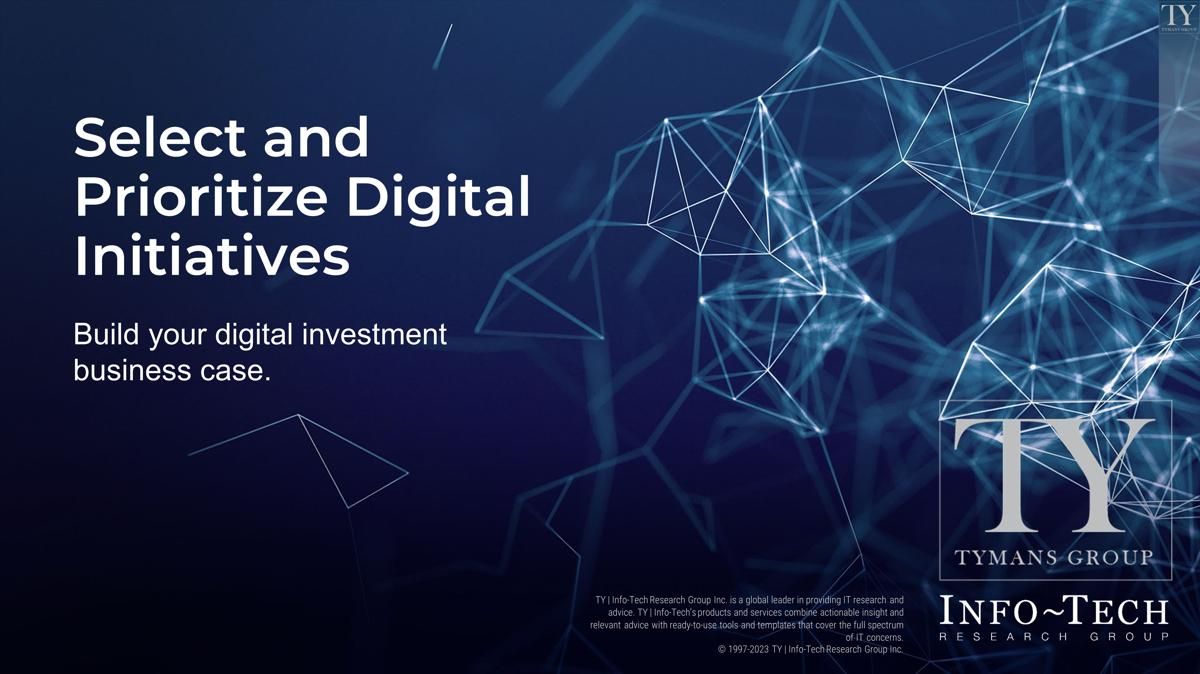
The business has embarked on its digital transformation journey. As CIO, you are being relied on to help triage what is most important – initiatives that will move the needle to achieve and fulfill the digital goals and ambitions of the organization.
- If selection criteria are not identified and well defined, then digital initiatives risk being misprioritized or, worse yet, incorrectly labelled as having high ROI.
- Like any other project, net-new digital initiatives must be triaged according to the value they bring to the organization.
- Just as importantly, the complexity of each initiative must also be weighed as a critical factor of success.
Our Advice
Critical Insight
Once the scope of the digital strategy and its goals are finalized, the heavy lifting begins. CIOs must prepare for this change by evaluating opportunities and prioritizing which will become digital initiatives.
Impact and Result
By using an appropriate selection process, CIOs can prioritize the digital initiatives that will matter most to the organization and drive business value.
Select and Prioritize Digital Initiatives Research & Tools
Besides the small introduction, subscribers and consulting clients within this management domain have access to:
1. Select and Prioritize Digital Initiatives Storyboard – A step-by-step document that walks you through how to prepare an IT department to embrace innovation and support the organization’s digital initiatives.
Part of Info-Tech’s seven-phase approach for aligning IT with the business’ digital strategy, this deck focuses the core and enabling initiatives that define IT’s innovation goals. By the end of this deck, the IT leader will have a roadmap of prioritized initiatives that enable the organization’s digital business initiatives.
- Select and Prioritize Digital Initiatives Storyboard
Further reading
Select and Prioritize Digital Initiatives
Build your digital investment business case.
Info-Tech Research Group
Info-Tech is a provider of best-practice IT research advisory services that make every IT leader’s job easier.| 35,000 members sharing best practices you can leverage. | Millions spent annually developing tools and templates. | Leverage direct access to over 100 analysts as an extension of your team. | Use our massive database of benchmarks and vendor assessments. | Get up to speed in a fraction of the time. |
Key Concepts
Digital initiative
A project – or a group of interdependent projects – whose primary purpose is to enable digital technologies and/or digital business models. These technologies and models may be net new to the organization, or they may be existing ones that are optimized and improved by the initiative itself.
The feasibility of any initiative is gauged by answering:
- What amount of return on investment (ROI) or value does it bring to the organization?
- What level of complexity does it pose to project execution?
- To what extent does it solve a problem or leverage an opportunity?
- To what degree is it aligned with digital business goals?
Digital strategy
The plan to deploy existing/emerging technologies to look at developing new products and services, new business models, and operational efficiency to meet or exceed performance targets.
IT strategy
The plan for deploying and maintaining applications, hardware, infrastructure, and IT services that support the business goals in a secure/regulatory-compliant manner to ensure reliability.
Digital transformation
Digital transformation is an at-scale change program – planned and executed over a finite time period – with the aspiration of creating material and sustainable improvement in the performance of an organization. Techniques include deploying a programmatic approach to innovation along with enabling technologies, capabilities, and practices that drive efficiency and create new products, markets, and business models.
Your Challenge
|
Common Obstacles
|
Solution
|
Info-Tech Insight
The business has embarked on its digital transformation journey. As CIO, you are being relied on to help triage what is most important – initiatives that will move the needle to achieve and fulfill the digital goals and ambitions of the organization.
Analyst Perspective
Prioritization follows ideation, and it’s not always easy.

Your stakeholders have spent considerable time and effort identifying and articulating a digital business strategy. Now that ideas have turned into opportunities, the CIO must prioritize those opportunities as actual initiatives. Where to begin?
Your first task is to identify the criteria that will be used to conduct prioritization activities. These criteria should be immutable and rigorously applied.
Your second task will be to develop business cases for each opportunity that passes muster. But don’t worry, you won’t need an MBA to get the job done properly.
Ross Armstrong
Principal Research Director
Info-Tech Research Group
Info-Tech’s digital transformation journey
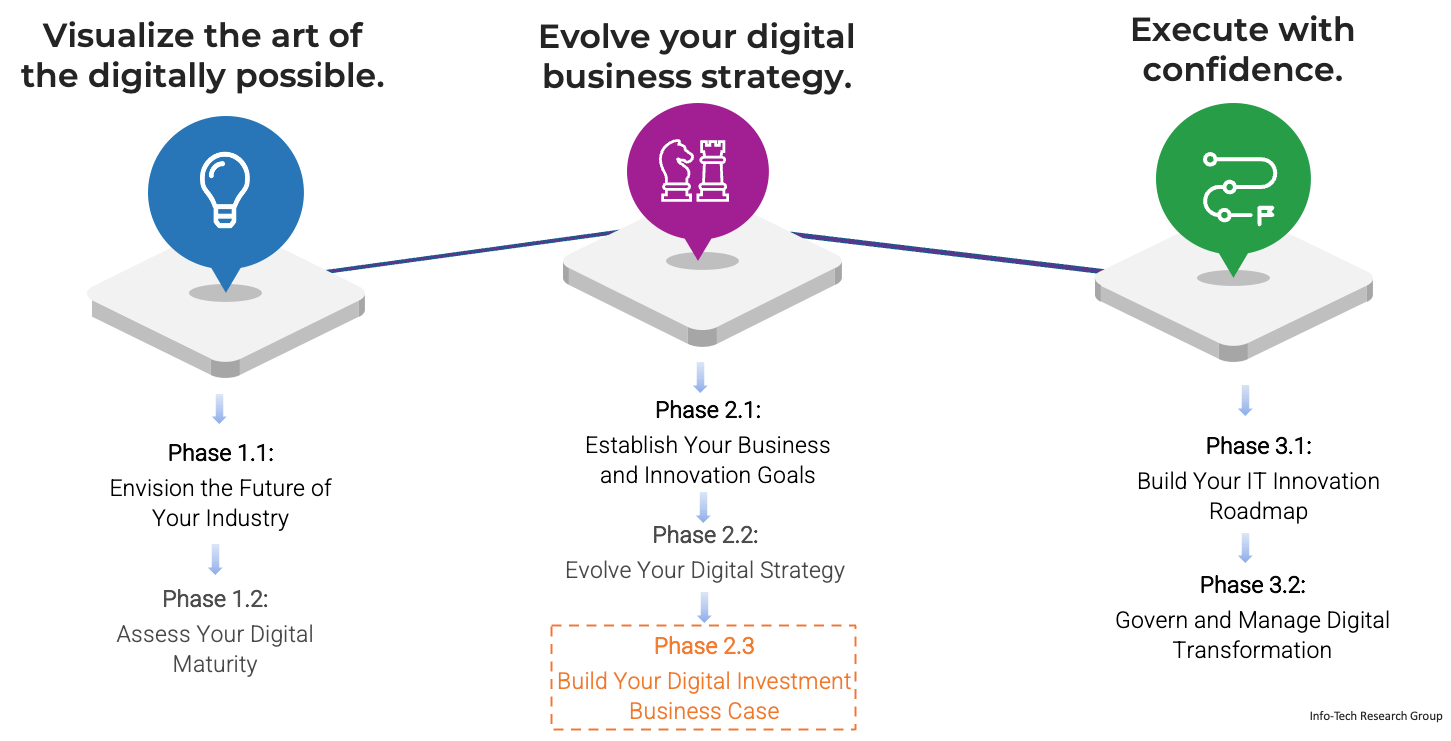
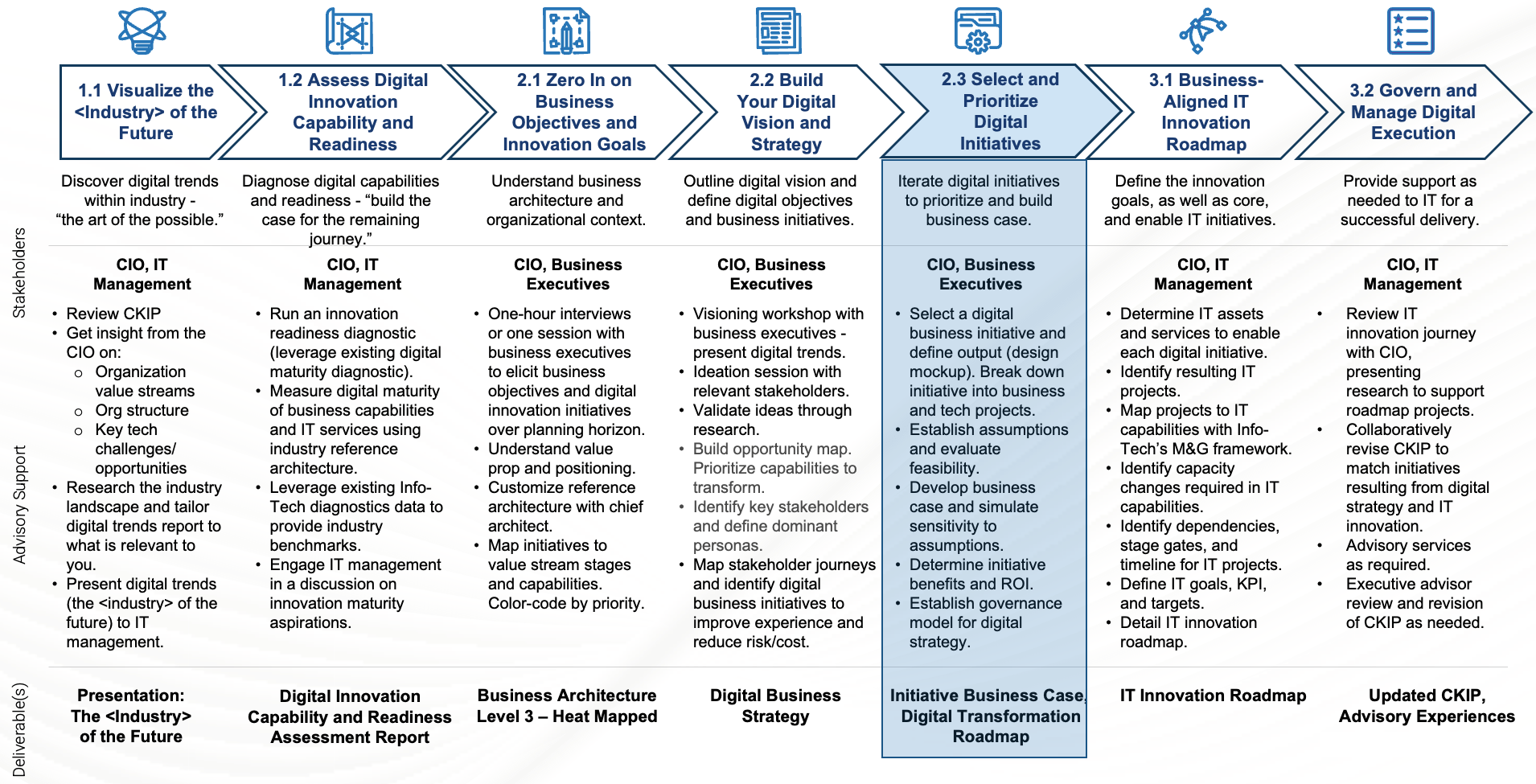
By now, you have established your current strategic context
You have reviewed trends to reimagine the future of your industry and undertaken a digital maturity assessment to validate your business objectives and innovation goals. Now you need to evolve the current scope of your digital vision and opportunities.
-
Phase 1.1: Industry Trends Report
-
Phase 1.2: Digital Maturity Assessment
-
Phase 2.1: Zero In on Business Objectives
By this point you have leveraged industry roundtables to better understand the art of the possible – exploring global trends, shifts in market forces or industry, customer needs, emerging technologies, and economic forecasts and creating opportunities out of these disruptions.
In Phase 2.1, you identified your business and innovation goals and documented your current capabilities, prioritized for transformation.
Business and innovation goals have been established through stakeholder interviews and business document review.
Current capabilities have been prioritized for transformation and heat mapped.
You have also formalized your digital strategy
Throughout the course of Phase 2.2, you identified new digital opportunities, identified the business capabilities required to capitalize those opportunities, and updated the digital goals of your organization, accordingly.
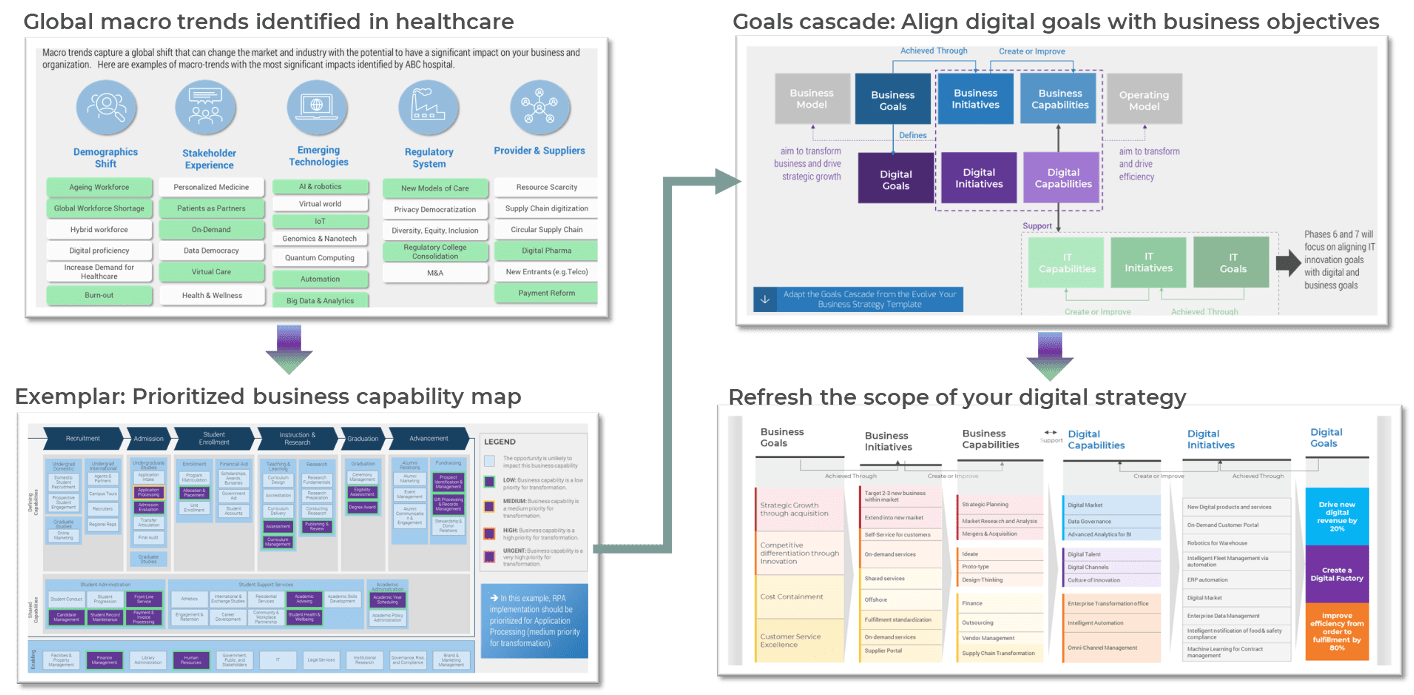
The end result of this exercise is a new goals cascade that aligns digital goals and capabilities with those of the business. Digital initiatives were also identified but not yet selected or prioritized for execution at the project level.
Now you will select and prioritize digital initiatives
The goal of this phase is to ensure that initiatives that are green-lit for execution have been successfully assessed against your chosen criteria and that the business case for each initiative is firmly established and documented.
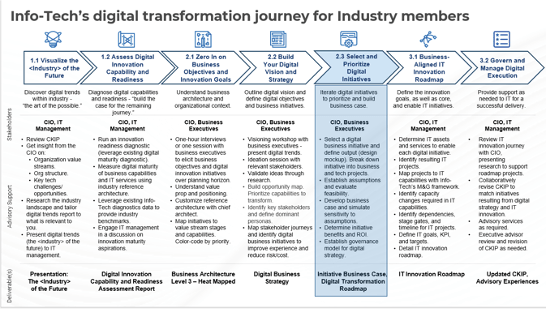
There are three key activities outlined here that describe the actions that can be undertaken by industry members to help select and prioritize digital initiatives for the business.
-
Identify your selection criteria
-
Evaluate initiatives against criteria
-
Determine a prioritized list of initiatives
Info-Tech’s approach
| 1 | Identify your selection criteria
|
| 2 | Evaluate initiatives against criteria
|
| 3 | Determine a prioritized list of initiatives
|
Step 1: Identify Your Selection Criteria
Understand which conditions must be met in order to turn an opportunity into a digital initiative.

Step 1
Identify Your Selection Criteria
1.1 |
Define what "viable" looks likeSet criteria types and thresholds.It is impossible to gauge whether or not an opportunity is worthwhile if you don’t have a yardstick to measure it by. However, what is viable for one organization in a particular industry may not be viable for a company elsewhere. |
Consider:
|
Avoid:
|
1.2 |
Conduct an evaluation sessionTest your assumptions by piloting prioritization.Select an initiative from one of the opportunity profiles from Phase 2.2 and run it through the selection criteria. From there, determine if your assumptions are sound. If not, tweak the criteria and test again until all stakeholders have confidence in the process. |
Consider:
|
Avoid:
|
Use these selection criteria to prioritize initiatives
Ideas matter, but not all ideas are created equal. Now that you have elicited ideas and identified opportunities, discuss the assumptions, risks, and benefits associated with each proposed digital business initiative.
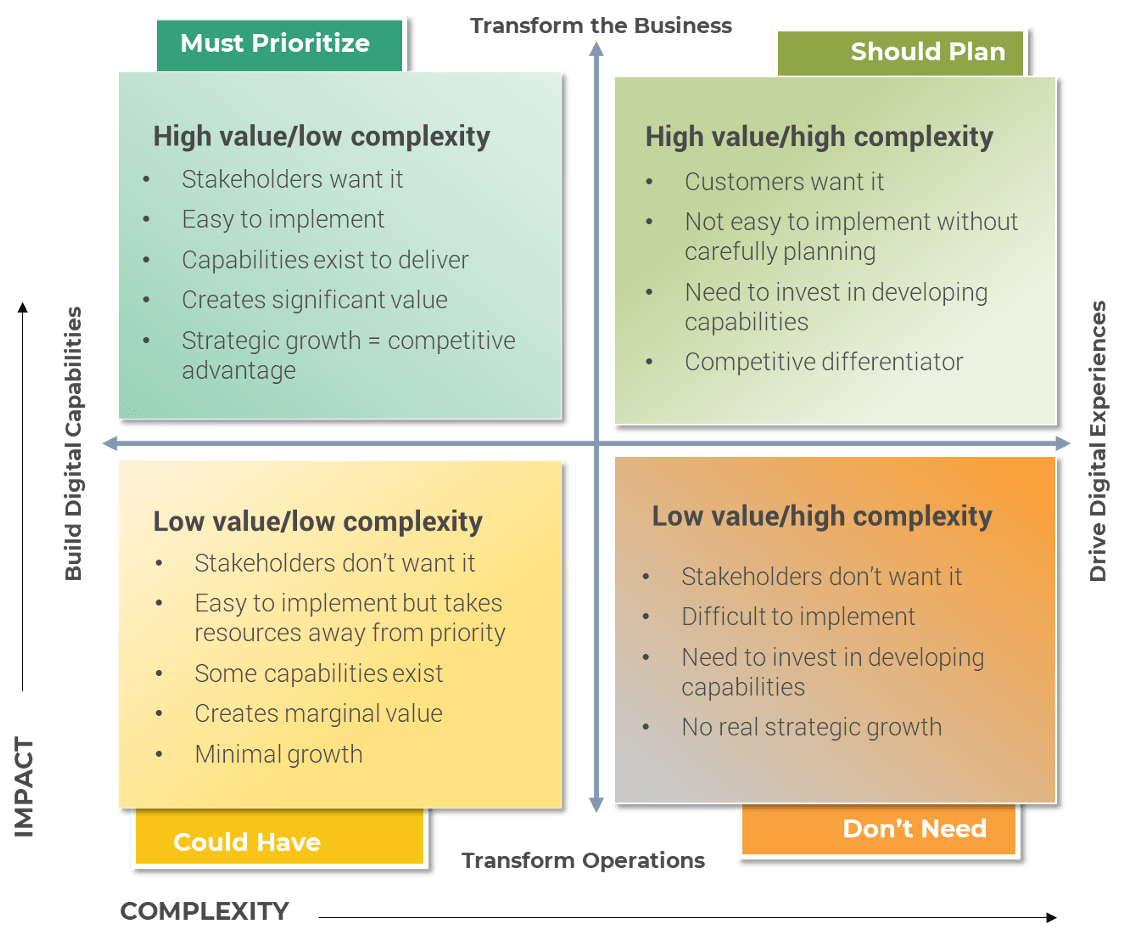
Prioritize opportunities into initiatives
Recall that the opportunities identified in Phase 2.2 also became proposed digital initiatives demonstrated in your goals cascade.
In your discussion, evaluate each opportunity through a matrix to create tension between value and complexity or other dimensions. Capture the information based on measurable business benefits-realization; risks or considerations; assumptions; and competencies, talent, and assets needed to deliver.
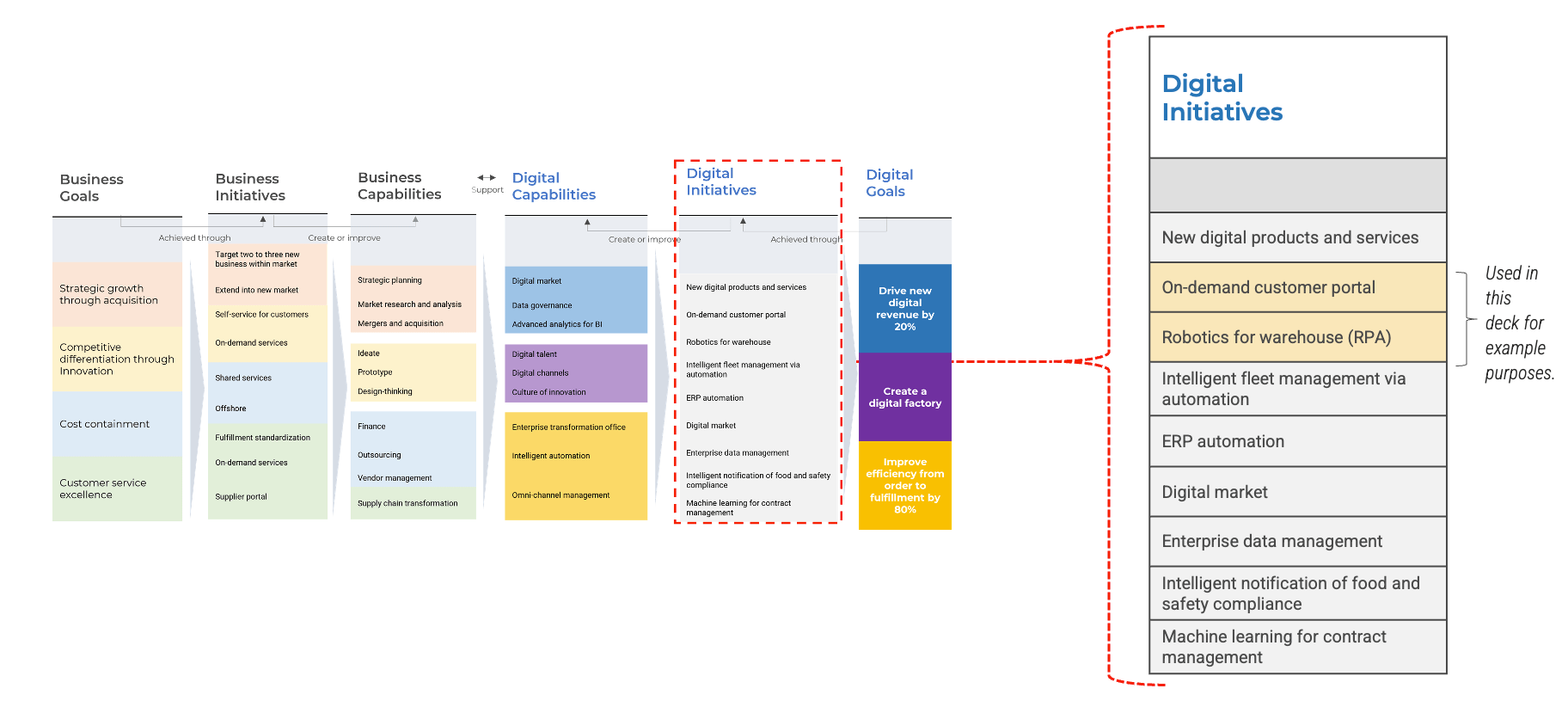
Leverage opportunity profiles from your digital strategy
To start, take one of the opportunity profiles you created in Phase 2.2, Build Your Digital Vision and Strategy, and use it throughout the following steps. Once done, repeat with the next opportunity profile until all have been vetted against criteria. If you did not use Info-Tech’s approach, simply use whatever list of digital business opportunities provided to you from stakeholders.
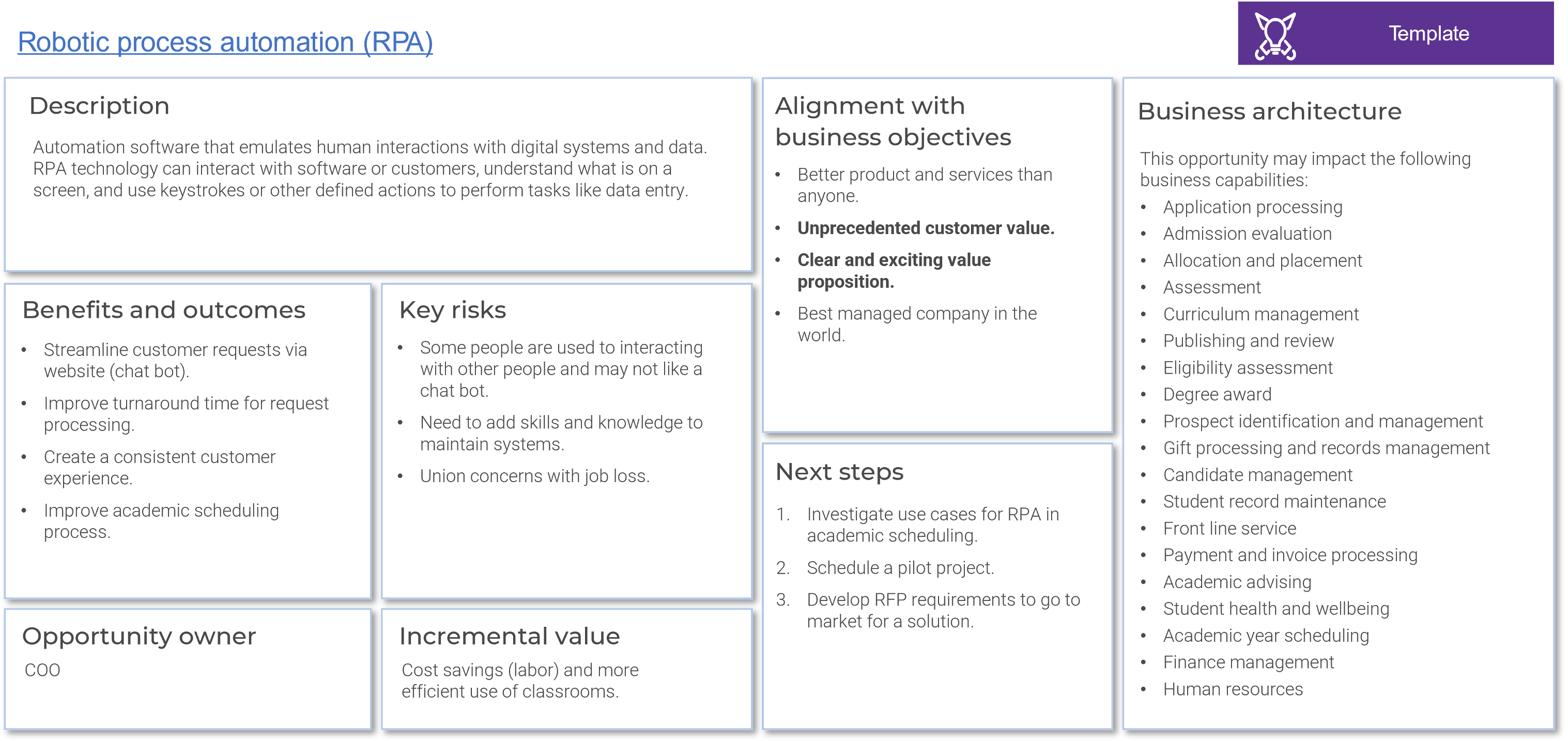
Prioritization Criteria
Run each initiative through the following evaluation criteria. When finished, any opportunities that appear in the top left quadrant (high value/low complexity) are now your highest priority digital initiatives.
Instructions:
Assign each initiative a letter. As you decide on each one, move a copy of the circled letter to its appropriate place on the 2x2 selection matrix.
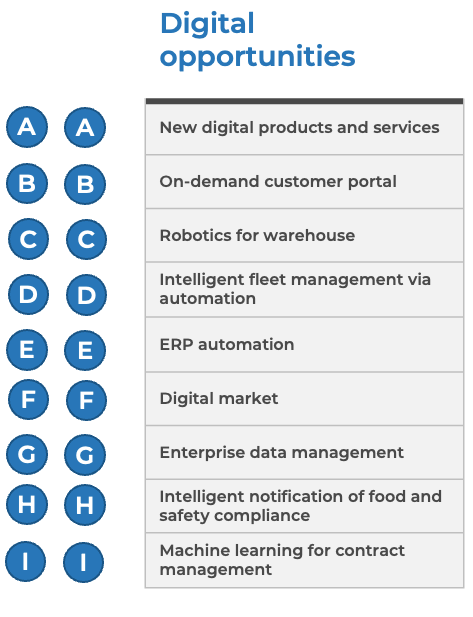

Info-Tech Insight
Evaluation should be based on the insights from analysis across all criteria. Leverage group discussion to help contextualize and challenge assumptions when validating opportunities.
Digital initiative ≠ IT project
Every idea is a good one, unless you need one that works. What “works” as a digital initiative is not the same thing as a straightforward IT project that would be typically managed by a project manager or PMO. These latter projects will be addressed in Phase 3.1 of the digital journey.
Opportunities and business needs > Business model > Impact > Mandatory > Innovation path forward
Digital Track
Focus: Transform the business and operations
- Problem may not be well defined.
- “Initiative” is not clear.
- Based on market research, customer needs, trend analysis, and economic forecast, risk to the business if fit-for-purpose initiative is not identified.
- Previous delivery results not as expected, or uncertain how to continue the project.
- Highly complex with significant impact to transform the business or operations.
- Execution approach is not clear.
- Capabilities may not exist within IT.
IT PMO
- Emerging technology trends create opportunities to modernize IT, not transform business.
- Problem is well defined and understood.
- Initiative is clearly identified.
- New IT project.
- Can be complex but does not transform the business.
- Standard PMP approach is a good fit.
- Capabilities exist to execute within IT.
- Software vendor or systems integrator is initiative provider.
Step 2: Evaluate Initiatives Against Criteria
Ruthlessly prioritize which opportunities will deliver the greatest business value and pose the best chance of success.

Step 2
Evaluate Initiatives Against Criteria
2.1 | Evaluate and validateEvaluate and validate (or invalidate) opportunities.Now that you have tested and refined the selection criteria, take each opportunity profile from Phase 2.2 and run it through its paces. Once plotted on the 2x2 matrix, you will have a clear and concise view of high priority digital initiatives. | Consider:
| Avoid:
|
2.2 | Determine benefitsDocument benefits and value proposition.Identify and determine the benefits of each high priority initiative, including the benefit type (e.g. observable, financial, etc.). In addition, discuss and articulate the value proposition for each high priority initiative. | Consider:
| Avoid:
|
2.3 | Make your caseBuild a business case for each initiative.Once you have enunciated the value and benefits of each high priority initiative, create a business case and profile for each one that includes known costs, risks, and so on. These materials will be crucial for project execution and IT capability planning in Phase 2.3 of your digital journey. | Consider:
| Avoid:
|
Exemplar: Prioritization criteria
Your prioritization matrix should look something like this. Initiatives B and C will now have short-form business cases developed for them. Initiatives in the “Should Plan” quadrant can be dealt with later.
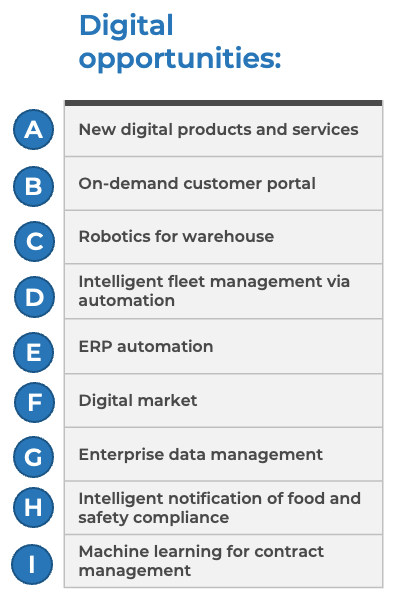
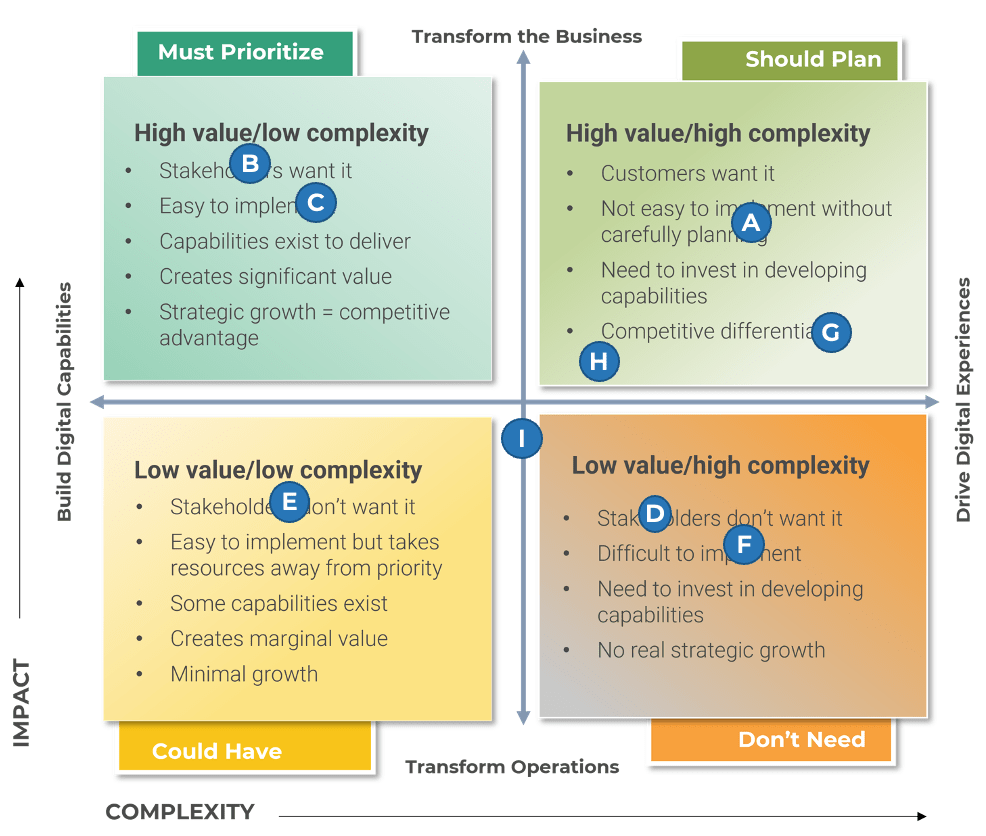
Draw information from the opportunity profiles
You created opportunity profiles in Phase 2.2 to clarify, validate and evaluate specific ideas for digital initiatives. In these profiles, you considered the timing, relevance, and impact of those opportunities.
Some prioritized initiatives will have an immediate and significant impact on your business. Some may have a significant impact, but on a longer timeline. Understanding this is important context for your overall digital business strategy.
Above all, you must be able to communicate to stakeholders how the newly prioritized digital initiatives are relevant to driving the strategic growth of the business.
Start by elucidating further on initiative benefits and business value as outlined in the opportunity profile. This will become crucial for completing your next step – building a short-form business case for each prioritized initiative.
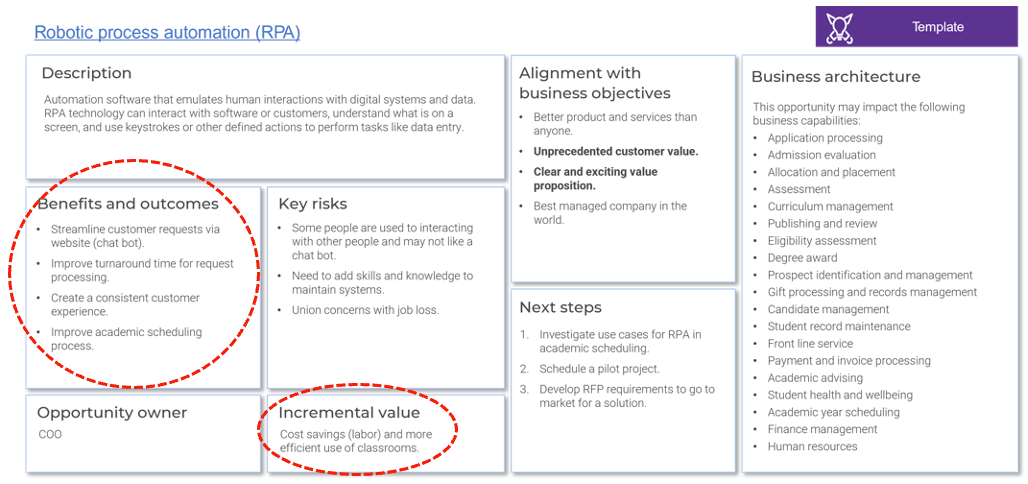 The next slide is a template for the short-form business case, while the slides after that contain instructions on how to fill out each section of the business case.
The next slide is a template for the short-form business case, while the slides after that contain instructions on how to fill out each section of the business case.
Short-Form Business Case Template
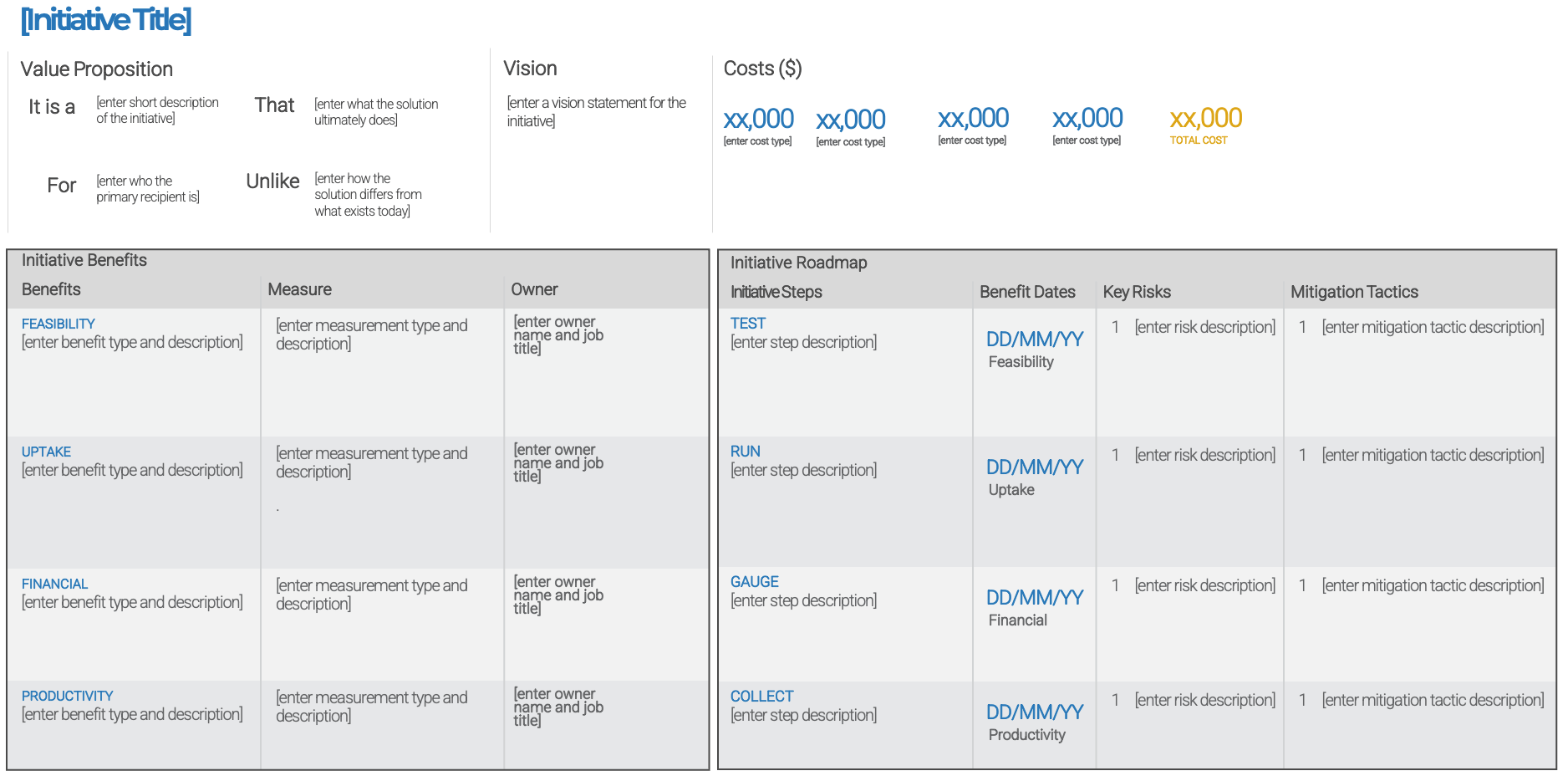
Prepare your business case for each initiative
Tasks:
- On a whiteboard, draw the visual initiative canvas supplied below.
- For each prioritized initiative, leverage its opportunity profile (if used) to list the resulting customer or stakeholder products/services and its pain relievers and gain creators in the associated sections of the canvas.
- Ensure that the top pains, gains, and jobs are addressed by products/services, pain relievers, and gain creators.
- Use this information as a basis for further exercises in this section, such as defining benefits, articulating value proposition and vision, and cost estimates.
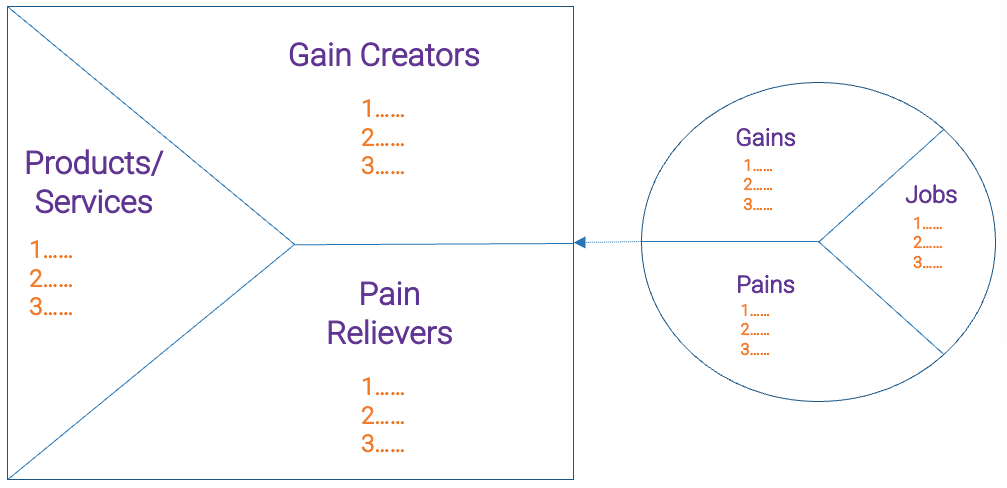
Input
|
Output
|
Materials
|
Participants
|
Expand on the key benefits of each initiative
Business cases are not just a vehicle with which to acquire resources for investments, they are a mechanism that helps ensure the benefits of an investment are realized. To accomplish this, a business case must have a set of clearly defined benefits, combined with an understanding of how they will be measured and an explicitly stated beneficiary who can corroborate that the benefit has been realized.
What is a benefit?
Benefits are the advantages, or outcomes, that specific groups or individuals realize as a result of the proposed initiative’s implementation.
Initiative inputs
Initiative inputs are the time, resources, and scope dedicated to the endeavor of implementing an initiative.

Identify how to measure benefit achievement
Benefits are realized when an organization either starts doing something new, stops doing something, or improves the way something is already being done. The impact of these changes must be measured in order to determine whether the change is positive and if the case warrants more resources in order to scale.
Types of benefits
- Observable: These are measured by opinion or judgement.
- Measurable: These can be identified when there is an existing measure in place for the benefit (or when one can be easily created).
- Quantifiable: Similar to measurable benefits; however, these benefits additionally feature size or magnitude (if it can be reliably estimated).
- Financial: These are benefits that can be communicated in monetary terms. A benefit should only be classified as financial when sufficient evidence is available to show that the stated value is likely to be achieved.
Benefit owners and responsibilities
- Each benefit should have assigned to it an explicit owner who gains an advantage as a result of the initiative’s implementation.
- For most benefits, the owner will be the primary beneficiary of the initiative.
- These individuals are the ones who must corroborate that a benefit has been realized.
- Assigning an owner to each benefit will foster a sense of accountability in terms of benefits realization and will also create a traceable path that helps track the success of the initiative.
Complete the benefits section of the business case
Tasks:
- Use the Short-Form Business Case Template included in this deck.
- Arrange a meeting with the key beneficiary or beneficiaries of your initiative. Refer back to the benefits and outcomes section of the initiative’s opportunity profile (if used) as a starting point.
- Clearly define what the key benefits of your initiative will be and list them in the Short-Form Business Case Template.
- Assign an owner to each benefit – the individual who will corroborate that the benefit has accrued.
-
Come to a mutual agreement with the beneficiaries as to whether each benefit is:
- Financial
- Quantifiable
- Measurable
- Observable
- Discuss and list the methods that will be used to measure each benefit and list them in the Short-Form Business Case Template.
Input
| Output
|
Materials
| Participants
|
Craft value proposition and vision statements
The way one articulates the value an initiative provides is just as important as the initiative itself. Use the previous exercises as inputs to craft a statement that reflects the value your initiative will provide, but also describes how the initiative will create value. Specifically, a value proposition should answer the following questions:
- Who is the initiative for?
- What is the initiative?
- What does the initiative do?
- How is the initiative different from others?
Complete value prop and vision statement sections of the business case
Tasks:
- Having already completed the benefits section of the Short-Form Business Case Template, turn your attention to the value proposition section.
-
Using your problem and initiative canvases, in addition to the benefits section, craft a value proposition statement
that answers the following questions in one or two sentences:
- Who is the initiative for?
- What is the initiative?
- What does the initiative do?
- How is the initiative different?
- Input the value proposition statement into the value proposition section of the Short-Form Business Case Template.
Input
| Output
|
Materials
| Participants
|
Identify initiative steps and add to business case
Tasks:
Turn your attention to the roadmap section of the Short-Form Business Case Template and fill it in through the following steps:
- Select which scope, resource, and/or time reduction tactics to apply given the context of the project.
- Use the test, run, gauge, and collect framework supplied, unless you elect to generate your own project phases. If that is the case, ensure that phases are mutually exclusive and completely exhaustive (MECE).
- For each phase, supply a brief description of the activities to be undertaken for that phase.
- Map the benefits to be accrued within each phase.
- For each phase, supply a set of two to three potential factors that create risk toward the benefits listed.
- For each risk, supply a mitigation tactic that could be employed to diffuse the risk or to mitigate it completely.
Input
| Output
|
Materials
| Participants
|
Fill out the cost section of the business case
Tasks:
- Having already completed the roadmap part of the Short-Form Business Case Template, turn your attention to the cost section.
-
Use the scope, resource, and time reduction tactics and roadmap to estimate the cost necessary to execute the project. Remember that costs are a factor of the resources required and the cost type.
-
Resources:
- Hardware
- Software
- Human
- Network and communications
- Facilities
-
Cost Types:
- Acquisition
- Operation
- Growth and change
-
Resources:
- Complete the cost section of the Short-Form Business Case Template with the cost estimate for the project.
Input
| Output
|
Materials
| Participants
|
Exemplar: Short-Form Business Case
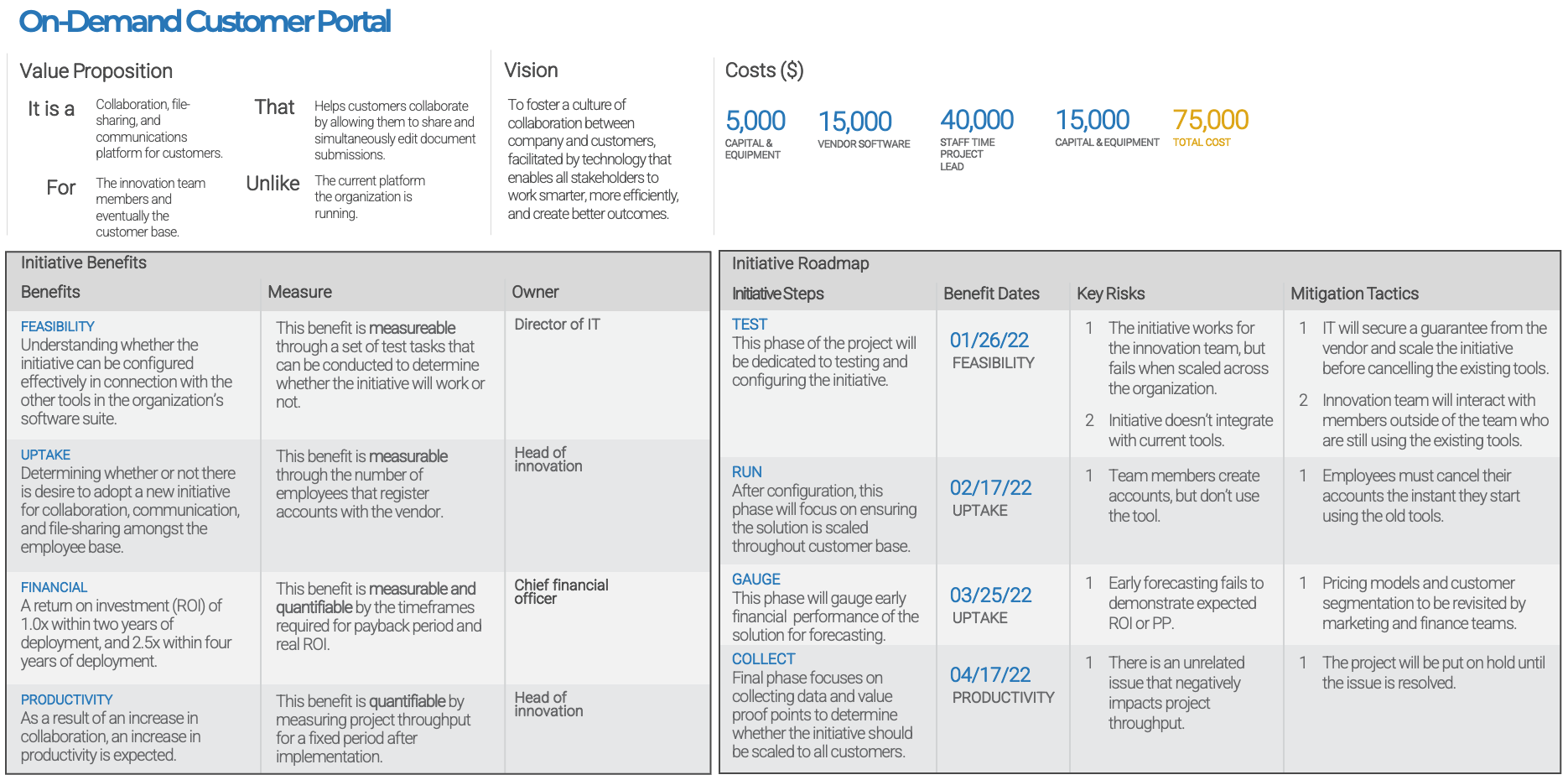
Step 3: Determine a Prioritized List of Initiatives
Green-light opportunities for digital investment and create your list of high-priority digital initiatives.

Step 3
Determine a Prioritized List of Initiatives
3.1 | Compile informationFinalize your list of high priority initiatives.This list should also include the short-form business cases that you completed in the previous step. This compilation of initiative information will be used in the next phase of your digital journey and is critical for its successful completion. | Consider:
| Avoid:
|
3.2 | CommunicateIt’s time to communicate with stakeholders.By now you should have a relatively short yet potent list of digital business initiatives – plus a business case for each – that has been thoroughly vetted and prioritized. Stakeholders are eager to learn more about these initiatives, though the details that matter most may differ from stakeholder to stakeholder. | Consider:
| Avoid:
|
Compile your prioritized initiatives
There are two follow-up actions to do with your newly prioritized list of digital initiative business cases: present them to stakeholders for approval and then add them to your IT strategic roadmap.
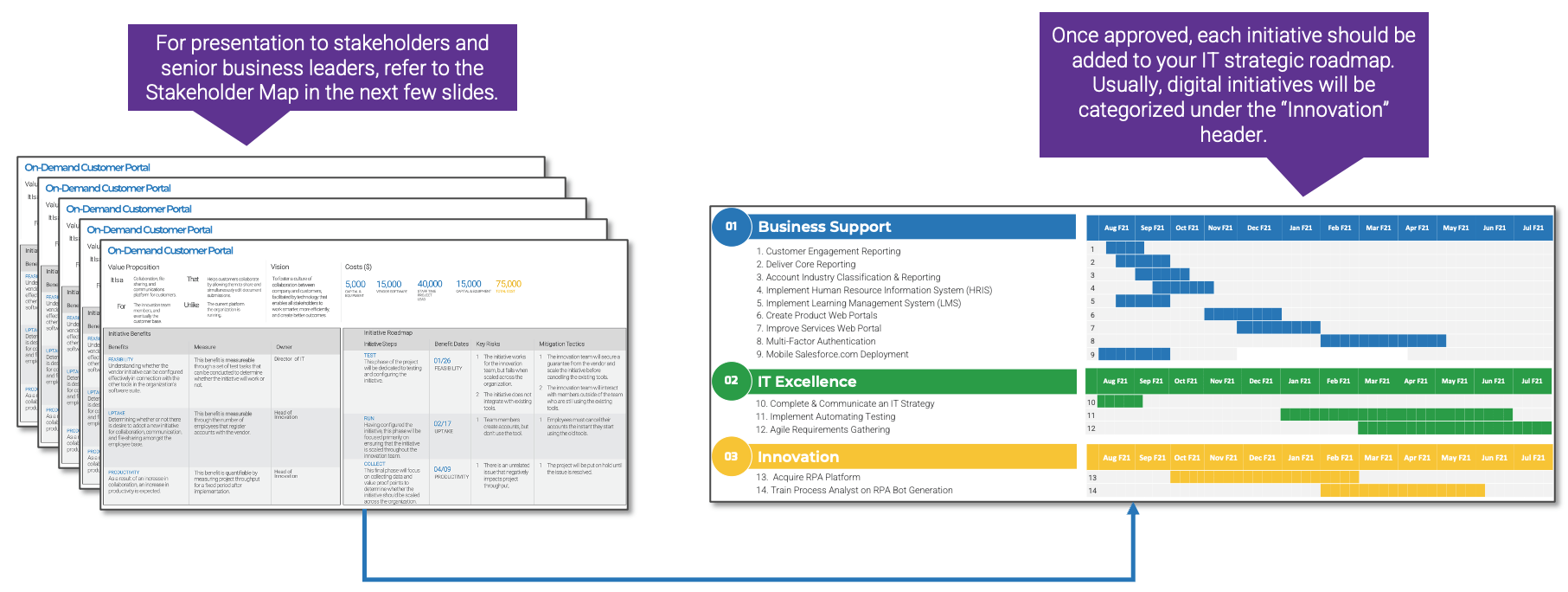
Present business cases to stakeholders
For most high-profile digital business initiatives, the short-form business case will not be the first time stakeholders hear about them. By this point, securing approval should only be a formality if the initiative has been effectively socialized beforehand. If this is not the case, one must build an adequate understanding of the stakeholder landscape and then use this understanding to effectively present business cases for digital initiative and receive approval to proceed with them.
Gauge the importance of various stakeholders and tailor your message according to their concerns and the requirements of their role. Consider the following important questions about each stakeholder:
- Authority: How much influence does the stakeholder have? Enough to drive the initiative forward?
- Involvement: How interested is the stakeholder? How involved is the stakeholder in the initiative already?
- Impact: To what degree will the stakeholder be impacted? Will this significantly change how they do their job?
- Support: Is the stakeholder a supporter of the initiative? Neutral? A resistor?
Develop a stakeholder map
A stakeholder map helps visualize the importance of various stakeholders and their concerns so you can prioritize your time according to those stakeholders who are most impacted by a digital initiative, as well as those who have the authority to green-light them.
- Evaluate each stakeholder in terms of authority, involvement, impact, and support, as discussed in the previous slide.
-
Map each stakeholder to an area on the right template (slide four) based upon the level of their authority and
involvement (high or low).
- Vary the size of the circle to distinguish stakeholders that are highly impacted by the IT strategy from those who are not. Color each circle to show each stakeholder’s estimated or gauged level of support for the project.
-
Ask yourself if the stakeholder map looks accurate. Is there someone who has no involvement in digital initiatives, but
should?
- A) For example, if a CFO who has the authority to disapprove project funding is heavily impacted and not involved, the success of the business cases will be put at risk.
-
Draw a dotted circle to show where that stakeholder needs to be located (increased involvement and support), and an
arrow with a dotted line to signify the needed change.
Some stakeholders may have influence over others.
- B) For example, a COO who highly values the opinion of the director of operations would be influenced by that director. Draw an arrow from one stakeholder to another to signify this relationship.
Focus on key players: Relevant stakeholders who have high power are highly impacted and should have high involvement. Engage the stakeholders that are impacted most and have the authority to influence digital initiatives and approve business cases.
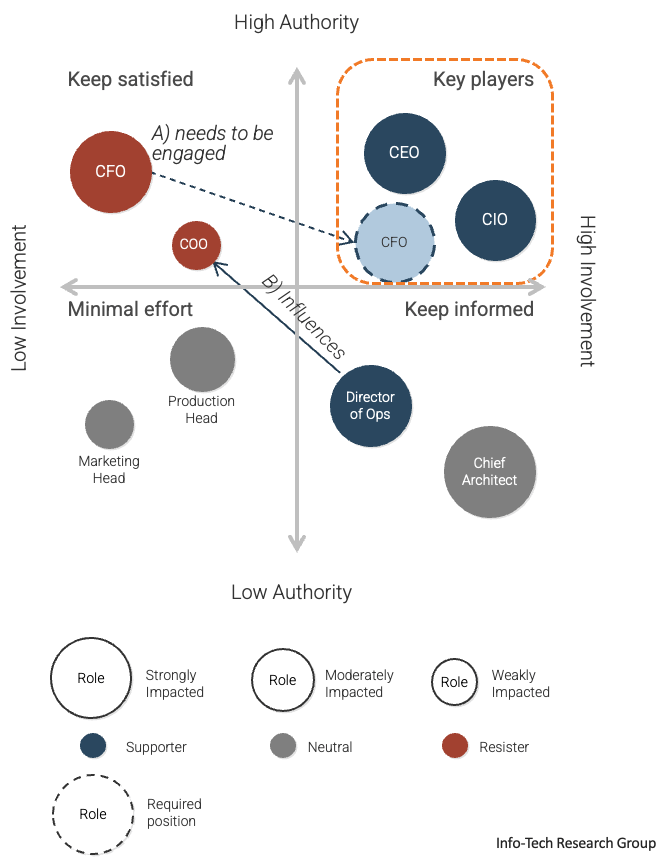
Summary of key insights
By now, you should have a firm understanding of the principles and desired actions, behaviors, and outcomes that have been presented in this methodology. Furthermore:
- Prioritization of digital opportunities can be a relatively straightforward task as long as the correct stakeholders are involved and use a common and agreed upon set of criteria.
- Developing a business case for a digital initiative in an agile manner need not be a grueling exercise provided that a vetted and repeatable process is used.
- Above all, remember that this is a journey. Going from an intangible (macro-trend, problem, or opportunity) to a tangible (actual project or initiative) does not happen all at once.
Related Info-Tech Research
Understand Industry Trends
Assess how the external environment presents opportunities or threats to your organization.
Build a Business-Aligned IT Strategy
Align with the business by creating an IT strategy that documents the business context, key initiatives, and a strategic roadmap.
Define Your Digital Business Strategy
Design a strategy that applies innovation to your business model, streamlines and transforms processes, and makes use of technologies to enhance interactions with customers and employees.
Research Contributors and Experts

Ross Armstrong
Principal Research Director, CIO Advisory
Info-Tech Research Group
Ross Armstrong is a Principal Research Director in the CIO Advisory practice at Info-Tech Research Group, covering the areas of IT strategic planning, digital strategy, digital transformation, and IT innovation.
Ross has worked in a variety of public and private sector industries including automotive, IT, mobile/telecom, and higher education. All of his roles over the years have centered around data-driven market research – in pursuit of insightful and successful product development and product management – at their core.
In addition to his long tenure as an Info-Tech Research Group analyst, Ross has worked in research and product innovation positions at Autodata initiatives (J.D. Power), BlackBerry, and Ivey Business School (Western University).
Ross holds a Master of Arts degree in English Language and Literature from Western University (UWO) and has served as an advisory board member for a number of not-for-profit and educational institutions.

Joanne Lee
Principal Research Director, CIO Advisory
Info-Tech Research Group
Joanne is an executive with over 25 years of experience providing leadership in digital technology and management consulting across both public and private entities from initiative delivery to organizational redesign across BC, Ontario, and Globally.
A Director within KPMG’s CIO Advisory Management Consulting services and practice lead for Digital Health in BC, Joanne has led various client engagements from ERP Cloud Strategy, IT Operating Models, Data and Analytics maturity, to process redesign. More recently, Joanne was the Chief Program Officer and Executive Director responsible for leading the implementation of a $450M technology and business transformation initiative across 13 hospitals and community services for one of the largest health authorities in BC.
A former clinician, Joanne has held progressive leadership roles in healthcare with accountabilities across IT operations and service management, data analytics, project management office (PMO), clinical informatics, and privacy and contract management. Joanne is passionate about connecting people, concepts, and capital.
Bibliography
“AI: From Data to ROI.” Cognizant, September 2020. Accessed November 2022.
Bughin, Jacques, et al. “The Case for Digital Reinvention.” McKinsey Quarterly, February 2017. Accessed November 2022.
“The Business Case for Digital Transformation.” CPA Canada, June 2021. Accessed November 2022.
“The Case for Digital Transformation.” The National Center for the Middle Market, Ohio State University, 2020. Accessed October 2022.
“Digital Transformation in Government Case Study.” Ionology, April 2020. Accessed October 2022.
Louis, Peter, et al. “Internet of Things – From Buzzword to Business Case.” Siemens, 11 January 2021. Accessed December 2022.
Miesen, Nick. “Case Studies of Digital Transformations in Process and Aerospace Industries.” Jugaad, 2018. Accessed November 2022.
Proff, Harald, and Claudia Bittrich. “The Digital Business Case - Done Right!” Deloitte, August 2019. Accessed October 2022.
“Propelling an Aerospace Innovator.” Accenture, 2021. Accessed October 2022.
Schmidt-Subramanian, Maxie. “The ROI of CX Transformation.” Forrester, 15 August 2019. Accessed November 2022.
Ward, John, et al. “Building Better Business Cases for IT Investments.” California Management Review, Sept. 2007. Web.
Buying Options
Select and Prioritize Digital Initiatives
IT Risk Management · IT Leadership & Strategy implementation · Operational Management · Service Delivery · Organizational Management · Process Improvements · ITIL, CORM, Agile · Cost Control · Business Process Analysis · Technology Development · Project Implementation · International Coordination · In & Outsourcing · Customer Care · Multilingual: Dutch, English, French, German, Japanese · Entrepreneur
Tymans Group is a brand by Gert Taeymans BV
Gert Taeymans bv
Europe: Koning Albertstraat 136, 2070 Burcht, Belgium — VAT No: BE0685.974.694 — phone: +32 (0) 468.142.754
USA: 4023 KENNETT PIKE, SUITE 751, GREENVILLE, DE 19807 — Phone: 1-917-473-8669
Copyright 2017-2022 Gert Taeymans BV